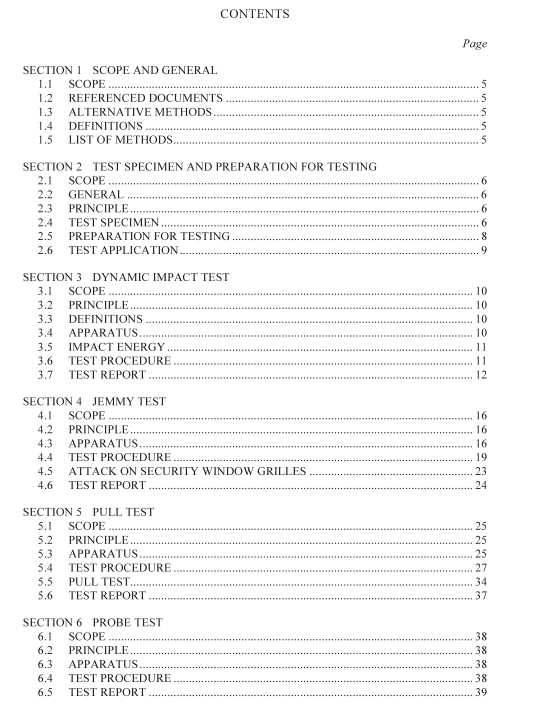AS 5041 pdf download – Methods of test—Security screen doors and window grilles

AS 5041 pdf download – Methods of test—Security screen doors and window grilles
The test specimen for Type I and Type II product shall consist of a piece of infill material with an incomplete pattern on one side and that side shall be subjected to the dynamic impact test as specified in Section 3. If the door or window fabricator manufactures a product with complete infill pattern then that configuration shall be tested. The results shall be taken as indicative for security window grilles smaller than the type test sample, and which are built by the same method. The security window grille shall be tested as submitted without any modification to the test specimen.
2.4.2.2 Hinges (for hinged window grilles only) For type testing, hinges shall be situated within 200 mm from the top and bottom of the window grille, measured to the centre of the hinge. Where more than two hinges are provided, they should be evenly spaced between the top and bottom hinges. Where a continuous hinge is used, the hinge shall be extended to within 200 mm from the top and bottom of the window grille.
2.5 PREPARATION FOR TESTING
2.5.1 General Where a security screen door or a security window grille is supplied as a complete screen door set or a complete window grille set, it shall be tested with its frame as supplied, closed and locked. Where a screen door or a window grille is supplied as a separate leaf, it shall be mounted to a full perimeter frame incorporating a minimum 10 mm × 20 mm stop bead rigidly fixed to the frame.
It shall be mounted according to the manufacturer’s fitting instruction, closed and locked. The test apparatus shall not be fixed to the timber frame in any way that would weaken the frame. Penetrations through the frame to fix stabilizing bars are acceptable as these strengthen the test rig. NOTE: Penetrations such as drilled holes and screw fixings into the frame may have a weakening effect which may affect the test results. The test frame shall be constructed from seasoned timber species commonly used in entry door frames in the region of installation from clear pinus radiata. The timber test frame profile size shall be as specified by the test authority, in the absence of any specification, the frame size shall be 90 mm × 35 mm. NOTE: Security doors or window grilles tested in softer timbers such as western red cedar may require additional and stronger fastenings whereas harder timbers such as Jarrah would transmit greater forces to the test specimen in the application of the Jemmy test. It is for this reason that clear pinus radiata was chosen as a timber exhibiting mid-range mechanical properties. Where the security door or window grille has been specifically designed for metal frames, the security door or window grille shall be fixed to a metal test frame in accordance with the manufacturer’s installation instructions.
2.5.2 Hinged doors Where a door is supplied as a complete door set, it shall be tested with its frame as supplied. Where a door is supplied as a separate leaf it shall be mounted to a full perimeter frame in accordance with the appropriate installation Standard. The door leaf shall fit flush to the door frame and have a clearance between the door and the frame at the hinging points shall not be more than 6 mm for steel doors and 4 mm for all other doors. The clearance between the door and the frame at the locking points shall be not more than 4 mm for all doors. At no point shall the clearance be less than 2.5 mm.
2.5.3 Sliding doors and window grilles Where the manufacturer supplying the specimen for test makes a product for a specific application (such as window manufacturer), then that product shall be mounted in a complete set for testing in accordance with the manufacturer’s installation instructions.









